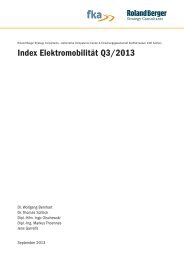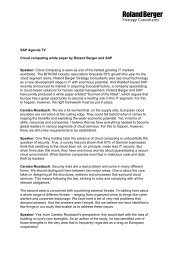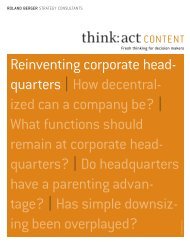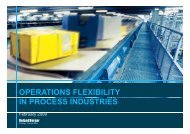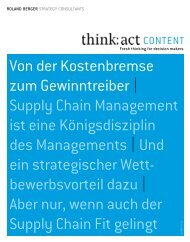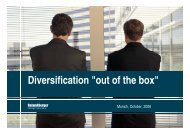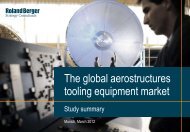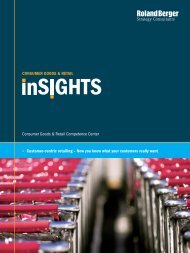Asset management in emerging markets - Roland Berger Strategy ...
Asset management in emerging markets - Roland Berger Strategy ...
Asset management in emerging markets - Roland Berger Strategy ...
- No tags were found...
Create successful ePaper yourself
Turn your PDF publications into a flip-book with our unique Google optimized e-Paper software.
<strong>Roland</strong> <strong>Berger</strong> <strong>Strategy</strong> ConsultantscontentFresh th<strong>in</strong>k<strong>in</strong>g for decision makersGo for the middle |<strong>Asset</strong> <strong>management</strong>can succeed <strong>in</strong>emerg<strong>in</strong>g <strong>markets</strong> |As long as it providestailored strategiesfor target segmentsJanuary 2012
content<strong>Asset</strong> ManagementPROJECTED GROWTH OF THEGLOBAL MIDDLE CLASS2030: 4.92020: 3.22012: 1.8Source : OECDbillionbillionbillion79%69%49%Grow<strong>in</strong>g share of middle class<strong>in</strong> emerg<strong>in</strong>g <strong>markets</strong>ASSET MANAGEMENT IN EMERGING MARKETSEmerg<strong>in</strong>g <strong>markets</strong> around the world are show<strong>in</strong>g themselves to be more than simply<strong>in</strong>vestment opportunities for asset managers. With global <strong>in</strong>flows on the rise, asset managersare turn<strong>in</strong>g to emerg<strong>in</strong>g <strong>markets</strong> to tap distribution and sales options and to sourcenew money. The doors for asset managers are open<strong>in</strong>g not just <strong>in</strong> BRIC countries and theNext Eleven, but also <strong>in</strong> regions like the Middle East with their impressive growth rates.Double-digit growth is with<strong>in</strong> reach for asset managers <strong>in</strong> South America, the Middle East,and even <strong>in</strong> parts of Asia Pacific. But there’s more to market entry than just macroeconomicpotential. Expand<strong>in</strong>g <strong>in</strong>to an emerg<strong>in</strong>g market, especially, requires close attention tothat market and its development path, and success depends on approaches and position<strong>in</strong>gthat are tailored accord<strong>in</strong>gly. It is the fact that these <strong>markets</strong> are <strong>in</strong> such flux thatnecessitate substantially robust strategies.A number of qualitative considerations should be factored <strong>in</strong>to an asset manager’s marketentry assessment, the level of basic bank<strong>in</strong>g penetration be<strong>in</strong>g one of them. The extent towhich a population is already served by f<strong>in</strong>anc<strong>in</strong>g and <strong>in</strong>vestment products is material tothe reach of the entry strategy. Another is the level of <strong>in</strong>vestor education, how muchknow-how <strong>in</strong>vestors <strong>in</strong> that market have on their own and other f<strong>in</strong>ancial <strong>markets</strong>, andhow sophisticated potential clients are. It is also important to look at the extent of thef<strong>in</strong>ancial market’s liberalization and stability; for example, can asset managers there readilyassess local stock changes, or are there <strong>in</strong>vestment restrictions or legal risks to consider?<strong>Asset</strong> managers should also look for patterns <strong>in</strong> <strong>in</strong>ternational outgo<strong>in</strong>g and <strong>in</strong>com<strong>in</strong>gf<strong>in</strong>ancial flows to determ<strong>in</strong>e whether <strong>in</strong>vestors are currently allocat<strong>in</strong>g money to or withdraw<strong>in</strong>gfunds from the country or region <strong>in</strong> question. The region’s <strong>in</strong>terest to foreignasset <strong>management</strong>, the ease of foreign entry, and whether local regulation fosters orhampers new bus<strong>in</strong>ess are also important considerations.TARGETED SEGMENTS, TAILORED STRATEGIESEven more than <strong>in</strong> an asset manager's home market, success <strong>in</strong> emerg<strong>in</strong>g economiesmeans align<strong>in</strong>g distribution channels and product offer<strong>in</strong>gs with the targeted segments –particularly given the lack of proprietary distribution channels for foreign entrants. Inother words, success entails hav<strong>in</strong>g a specific "go-to-market" approach. To build such anapproach, players must first assess their current position<strong>in</strong>g and move to close any gaps<strong>in</strong> their bus<strong>in</strong>ess models through organic development or strategic partnerships.Emerg<strong>in</strong>g <strong>markets</strong>:Significant growth opportunityfor asset managersAfricaSouth AmericaMiddle EastAPACCompound annual growth rate, 2006 - 2010Source: <strong>Roland</strong> <strong>Berger</strong>The Global Middle Class WILL GROW160%by more than<strong>in</strong> the next 25 yearsFor asset managers, tapp<strong>in</strong>g <strong>in</strong>to an emerg<strong>in</strong>g region or country first and foremost meansisolat<strong>in</strong>g the most attractive and approachable client segments. The distribution strategyand product offer<strong>in</strong>g can then be aligned accord<strong>in</strong>gly, tailored to segment particularities.While wealthy clients may expect <strong>in</strong>dividual coverage and customized solutions, middleand lower segments may respond better to a strong product-push strategy that usesstandardized products.Recent European reports <strong>in</strong>dicate that the top asset managers have <strong>in</strong>curred more netasset <strong>in</strong>flows <strong>in</strong> their top ten funds than <strong>in</strong> the rest of their portfolios comb<strong>in</strong>ed. Trends <strong>in</strong>Europe, <strong>in</strong> players like Frankl<strong>in</strong> Templeton and Allianz Global Investors, will resonate <strong>in</strong>emerg<strong>in</strong>g regions as well. Independent F<strong>in</strong>ancial Advisers (IFAs), for example, will want to
<strong>Roland</strong> <strong>Berger</strong> <strong>Strategy</strong> Consultantscontent<strong>Asset</strong> ManagementMAJOR potential leverage7%=33%GDPGlobalsovereignwealthMiddle Eastern countries currently accountfor one-third of the sovereign wealth of theentire globe, though they account for lessthan 7% of global GDPsee large and well-known flagship funds that they can sell to their clients. Solid expertiseand sufficient scale will underp<strong>in</strong> an asset manager's ability to secure such resources.To illustrate the necessity for alignment between segments and strategies, let’s take alook at the general retail middle market. This segment prefers face-to-face <strong>in</strong>teraction andadvisor-based channels. To service the retail middle market, an asset manager needsaccess to an established distribution footpr<strong>in</strong>t. This could be through a traditional brickand-mortarretail branch network or via an IFA. Product offer<strong>in</strong>gs must leverage themarket's opportunities without alienat<strong>in</strong>g <strong>in</strong>vestors or runn<strong>in</strong>g up costs. <strong>Asset</strong> managerstarget<strong>in</strong>g the average retail middle market have to keep <strong>in</strong> m<strong>in</strong>d that simple one-ticket productsmake for a high level of automation, that the advice required is low-frequency andlow-depth, and that the customization options are few.The fluctuat<strong>in</strong>g character of emerg<strong>in</strong>g economies <strong>in</strong>sists that strategies be tailored to thesegments they target, perhaps to an even larger degree than many asset managers areaccustomed to. The case of middle <strong>markets</strong> <strong>in</strong> the Middle East illustrates this correlation,and how asset managers can succeed <strong>in</strong> its midst.THE CASE OF MIDDLE MARKETS IN THE MIDDLE EASTThe Middle East is open<strong>in</strong>g up, but not <strong>in</strong> the way commonly assumed. Surpris<strong>in</strong>gly, thevast pools of <strong>in</strong>stitutional wealth and the super rich should not be the targets of assetmanagers; rather, the real opportunities lie <strong>in</strong> the middle market. Similar trends can beobserved elsewhere <strong>in</strong> other emerg<strong>in</strong>g economies like Asia. As the petrodollars haveaccumulated, the Middle East has enjoyed large pools of <strong>in</strong>stitutional wealth. MiddleEastern countries currently account for one-third of the sovereign wealth of the entireglobe, though they account for less than 7% of global GDP. But access<strong>in</strong>g these assetpools is no easy task. Sovereign Wealth Funds (SWFs) are the most prom<strong>in</strong>ent state-owned<strong>in</strong>vestment vehicles <strong>in</strong> the region, and they typically manage a substantial part of theirassets <strong>in</strong>-house. SWFs are highly sophisticated <strong>in</strong>vestors, so asset managers would haveto prove long, successful track records and advanced <strong>in</strong>ternal processes before they caneven hope to be shortlisted. SWFs, furthermore, prefer global diversification over regional<strong>in</strong>vestment. Gett<strong>in</strong>g anywhere near them will be an uphill battle for an asset managerenter<strong>in</strong>g the region.The super rich <strong>in</strong> the Middle East, its high net worth <strong>in</strong>dividuals (HNWIs), control 4% ofglobal private wealth. In absolute terms this equals roughly USD 1.5 trillion – no negligiblefigure. But they tend to <strong>in</strong>vest their wealth offshore <strong>in</strong> private bank<strong>in</strong>g hubs likeSwitzerland or S<strong>in</strong>gapore, which means, aga<strong>in</strong>, asset managers will be hard pressed to ga<strong>in</strong>access to their funds. In the Middle East, <strong>in</strong> reality, it is the middle market that holds themost potential for asset managers. Out of a total of 24.2 million adults, 7.0 m or 29% makeup the middle market across the affluent, mass affluent and upper mass <strong>in</strong>come segments.The upper mass segment is the most sizeable segment of the middle market, witha bankable population of 3.9 million, <strong>in</strong>vestable assets between USD 20,000 and 100,000,and represent<strong>in</strong>g a potential asset pool of at least USD 78 billion. But the most attractivemiddle market segment <strong>in</strong> the Middle East is the mass affluent segment. With 2.5 millionadults hold<strong>in</strong>g <strong>in</strong>vestable assets between USD 500,000 to to 1 million, this segment representsa potential total wallet of USD 1.25 trillion or more. In other words, the middle market<strong>in</strong> the Middle East rivals the super rich <strong>in</strong> terms of asset <strong>management</strong> potential. The longheldassumption that most wealth <strong>in</strong> the region is concentrated with the HNWIs is clearlydebatable. The Middle East illustrates how today's asset managers can succeed <strong>in</strong> anemerg<strong>in</strong>g market – <strong>in</strong> this case, <strong>in</strong> the middle market. Our own experience and analysesmake it clear that the successful bus<strong>in</strong>ess models <strong>in</strong> this region and market entail differentblends of <strong>in</strong>sourced and outsourced asset <strong>management</strong> activities. A framework of exist<strong>in</strong>gbus<strong>in</strong>ess models allows us to categorize asset <strong>management</strong> players accord<strong>in</strong>g to their currentposition<strong>in</strong>g – and thus to suggest next steps for successful middle market entry, <strong>in</strong>the Middle East or elsewhere. <strong>Asset</strong> managers eye<strong>in</strong>g the region must look to their availabledistribution and <strong>in</strong>vestment expertise first. Know<strong>in</strong>g where one stands is the first steptowards a solid bus<strong>in</strong>ess model – and ultimately towards growth.1 – Established Middle Eastern banks without an asset <strong>management</strong> franchiseWith renowned brands and established brick-and-mortar branch networks, most retailbanks <strong>in</strong> the Middle East are likely to already have a bank<strong>in</strong>g relationship with the middlemarket and its most attractive segments.Due to long-established reliance on bank deposits and sav<strong>in</strong>gs accounts, most retailbanks have not pursued asset <strong>management</strong>. But ris<strong>in</strong>g levels of <strong>in</strong>vestor education anddevelop<strong>in</strong>g capital <strong>markets</strong> have made Middle Eastern banks <strong>in</strong>creas<strong>in</strong>gly <strong>in</strong>terested <strong>in</strong>diversify<strong>in</strong>g their revenue streams via asset <strong>management</strong>. To leverage this opportunity,banks can opt to either partner with a renowned asset <strong>management</strong> brand <strong>in</strong> retail ororganically develop an asset <strong>management</strong> operation from scratch. In either case, banksneed to provide a compell<strong>in</strong>g value proposition to retail <strong>in</strong>vestors. To start, the retail bank<strong>in</strong>gbrand should be perceived as trustworthy. To achieve this, banks should either be ableto capitalize on a long-stand<strong>in</strong>g history <strong>in</strong> retail bank<strong>in</strong>g or should consider specific measuresto be perceived as a credible advisor. The bank should also have an established retailbranch network so that it can do its bus<strong>in</strong>ess face-to-face. Onl<strong>in</strong>e channels are on the rise,but for a new entrant this should be seen as an "add-on" rather than a standalone strategy.Product push is still too difficult <strong>in</strong> the region. In the same ve<strong>in</strong>, simple and easy to understand<strong>in</strong>vestment solutions should be offered that can reach the vary<strong>in</strong>g levels of <strong>in</strong>formed<strong>in</strong>vestors across the Middle East. Customers must first get used to <strong>in</strong>vest<strong>in</strong>g <strong>in</strong> funds, sostart<strong>in</strong>g with a basic and easy-to-understand product range will facilitate this learn<strong>in</strong>gcurve. This also means that the bank should have a solid track record and <strong>in</strong>vestmentexperience. Investors are often <strong>in</strong>secure about the "right" <strong>in</strong>vestment, so banks and assetmanagers need to alleviate their target customers' concerns from the outset. Build<strong>in</strong>g atrack record, however, obviously requires several years; partner<strong>in</strong>g with establishedplayers might be a valuable option while a bank is build<strong>in</strong>g its own reputation.F<strong>in</strong>ally, the asset manager and bank<strong>in</strong>g sales <strong>in</strong>centives for retail advisors should bealigned. From an asset manager’s perspective, what matters are not only high <strong>in</strong>flows ata specific po<strong>in</strong>t <strong>in</strong> time but also, and perhaps even more so, asset under <strong>management</strong>Trillion to spend125000000000000USDIn the Middle East, it is the middle marketthat holds the most potentialEstablished banks/no asset<strong>management</strong> franchiseEstablished Brand& Distribution1 32 4Investment Expertise
<strong>Roland</strong> <strong>Berger</strong> <strong>Strategy</strong> Consultantscontent<strong>Asset</strong> ManagementNew entrant banks startfrom scratchEstablished Brand& DistributionEstablished asset managersshould focus on a tailoredoffer<strong>in</strong>gEstablished Brand& Distribution1 32 4Investment Expertise1 32 4Investment Expertiseretention over time. This means that asset managers must not only aim to maximize their<strong>in</strong>flows but also to keep the assets <strong>in</strong>-house over time and avoid attrition (i.e. outflows) sothat they can earn <strong>management</strong> fees over the long term. Retail sales advisors, therefore,should be <strong>in</strong>centivized to foster client loyalty and avoid attrition.2 – New entrant banks or Independent F<strong>in</strong>ancial Advisers (IFAs)With little or no brand recognition, no distribution network nor proven <strong>in</strong>vestment expertise,new entrants can tap asset <strong>management</strong> opportunities by first either develop<strong>in</strong>g theirbrands/distribution or their <strong>in</strong>vestment expertise.In the first scenario, new entrants to the Middle East can distribute third-party productsthrough commission-based platforms or white-label distribution agreements <strong>in</strong> order todevelop their distribution and brand position<strong>in</strong>g. A well-def<strong>in</strong>ed and fairly focused valueproposition for each segment will lure new clients away from exist<strong>in</strong>g players. S<strong>in</strong>ce mostretail onshore assets under <strong>management</strong> <strong>in</strong> the Middle East are currently held <strong>in</strong> captivebank-owned funds and other products, clients can represent more value through a focusedoffer<strong>in</strong>g. Banks should also be able to provide access to key flagship funds from renownedasset managers. Most retail bank<strong>in</strong>g clients <strong>in</strong> the region are restricted to own<strong>in</strong>g theirbank's funds, so offer<strong>in</strong>g access to well-known regional and global flagship funds wouldprovide <strong>in</strong>vestors with a best-<strong>in</strong>-class offer<strong>in</strong>g from a s<strong>in</strong>gle provider. Attractive launchpromotions or price discounts will also be helpful. With current distribution marg<strong>in</strong>s athigher levels than <strong>in</strong> developed <strong>markets</strong>, Middle Eastern new entrants can afford to provideattractive f<strong>in</strong>ancial <strong>in</strong>centives to lure new clients. In any case, the asset <strong>management</strong>platform should be seamlessly <strong>in</strong>terwoven with the rest of the customer offer<strong>in</strong>g.Operational efficiency will be key to maximiz<strong>in</strong>g sales. Organizations which are able to<strong>in</strong>tegrate their asset <strong>management</strong> platform with<strong>in</strong> their current e-platform will be bestpositioned to take advantage of direct/e-bank<strong>in</strong>g as it ga<strong>in</strong>s a hold across the Middle East.The second scenario calls for <strong>in</strong>-house <strong>in</strong>vestment expertise. Entrants can either acquireor build an <strong>in</strong>vestment team through targeted hir<strong>in</strong>g. The key is an ability to attract andreta<strong>in</strong> outstand<strong>in</strong>g <strong>in</strong>vestment talent. This may be trickier <strong>in</strong> the Middle East, where thelocation of the <strong>in</strong>vestment team will play a critical role <strong>in</strong> a firm's ability to attract the rightpeople. Along with location, a well-def<strong>in</strong>ed compensation structure and long-term <strong>in</strong>centiveschemes will be what attracts and reta<strong>in</strong>s an <strong>in</strong>vestment team. Stay<strong>in</strong>g <strong>in</strong> the market –with the consistency of a strong team – is what will build a track record that can later competehead-to-head with exist<strong>in</strong>g players. As with other grow<strong>in</strong>g <strong>markets</strong>, entrants need toview their entrance as a long-term, susta<strong>in</strong>ed <strong>in</strong>vestment.3 – Established <strong>in</strong>cumbent asset managersEstablished asset managers need to re<strong>in</strong>force their exist<strong>in</strong>g value proposition to fend offnew entrants. They can achieve this by either build<strong>in</strong>g significant scale or by further deepen<strong>in</strong>gtheir <strong>in</strong>vestment expertise <strong>in</strong> certa<strong>in</strong> <strong>in</strong>vestment areas. Build<strong>in</strong>g scale <strong>in</strong>volves anumber of measures. A broad and well-established distribution network, potentially us<strong>in</strong>g amix of captive and third-party channels, can reach large numbers of potential clients witheasy and convenient products. But rather than try<strong>in</strong>g to compete with a "one size fits all"approach, a tailored offer<strong>in</strong>g should be available for more wealthy and demand<strong>in</strong>g clients,and standard offer<strong>in</strong>gs kept to the lower tiers of the middle market segment. Furthermore,critical mass <strong>in</strong> assets under <strong>management</strong> will allow asset managers to lower operat<strong>in</strong>gfees and better compete on pric<strong>in</strong>g. When a player reaches a certa<strong>in</strong> scale, it can lower unitcosts and even potentially pass on some cost advantages to retail <strong>in</strong>vestors or third-partydistribution channels, if and when needed. To further leverage scale, managers should alsoseek out optimization options for middle and back office operations and processes. A properly<strong>in</strong>centivized sales force will further support asset retention. This might <strong>in</strong>clude notonly upfront commission schemes but deferred compensation schemes based on assetsunder <strong>management</strong> levels and net flows over time.Deepen<strong>in</strong>g <strong>in</strong>vestment expertise, <strong>in</strong> the case of <strong>in</strong>cumbents, first implies assess<strong>in</strong>g theexpertise currently available, and then the areas for improvement. Implementation of thesubsequent changes should be documented and shared with clients, which will lead toproactive market<strong>in</strong>g of the new or improved expertise range. Next, the compensation structure<strong>in</strong> the front office should be competitive. This means an employee value proposition,attractive remuneration packages that reward outperformers, and clear developmentpaths for "superstars". Performance-based <strong>in</strong>centives for the front office staff and the firmas a whole should be aligned. And f<strong>in</strong>ally, the asset manager should have a proven and sufficienttrack record of add<strong>in</strong>g value. This must be built up over time. Initially, upfront <strong>in</strong>vestmentswill have to be made, and payback will be <strong>in</strong> the mid-term. The asset manager thereforeneeds a "stay the course" attitude.4 – Lead<strong>in</strong>g global asset managersMult<strong>in</strong>ational asset managers look<strong>in</strong>g to enter the Middle Eastern retail market can offer<strong>in</strong>vestors trusted and proven products that are managed by world-class <strong>in</strong>vestmentmanagers with long-term track records. However, their expansion of products and salesactivities <strong>in</strong> the region should be gradual, and such players should avoid the temptation tobuild a fully-fledged branch network or local middle or back offices. Such moves would notonly be costly; they would reduce economies of scale and thus potentially lead to largeproblems down the l<strong>in</strong>e. Lead<strong>in</strong>g global asset managers should therefore focus on a selectnumber of flagship products with sufficient marg<strong>in</strong>s, offer local variations (e.g. Shariacompliantvariations), partner with renowned retail brands and distribution networks, andprovide on-the-ground sales tra<strong>in</strong><strong>in</strong>g and support.EMERGING MARKETS, EMERGING CHANCESThe Middle East is one of several attractive and emerg<strong>in</strong>g <strong>markets</strong> that asset managerscan tap for expansion opportunities. As with any market entry, success relies on welldef<strong>in</strong>edgo-to-market strategies that address local specifics. The flux of these emerg<strong>in</strong>g<strong>markets</strong>, especially given their lack of proprietary distribution channels for foreignentrants, demands airtight alignment between the targeted segments and the assetmanager’s own distribution channels and product offer<strong>in</strong>gs. With properly aligned bus<strong>in</strong>essmodels and entry strategies, asset managers can seize the new distribution and salesopportunities aris<strong>in</strong>g <strong>in</strong> these emerg<strong>in</strong>g economies. The Middle East is an apt model forasset managers look<strong>in</strong>g at expansion, especially beyond the traditional asset geographies.Lead<strong>in</strong>g global asset managersshould expand activities graduallyEstablished Brand& Distribution1 32 4Investment ExpertiseIF YOU HAVE ANY QUESTIONS,PLEASE FEEL FREE TO CONTACT US:Dr. Frank Heideloff, Partner+49 40 37631 - 4448frank_heideloff@de.rolandberger.comMatthias Hübner, Pr<strong>in</strong>cipal+49 89 9230 - 8910matthias_huebner@de.rolandberger.comJoe Nakhle, Project Manager+973 17 567 - 994joe_nakhle@bh.rolandberger.comth<strong>in</strong>k:act CONTENT…ditors:Prof. Dr. Burkhard Schwenker, Dr. Mart<strong>in</strong> C. WittigProject <strong>management</strong>: Dr. Kather<strong>in</strong>e Nöll<strong>in</strong>gDesign: <strong>Roland</strong> <strong>Berger</strong> Media Design<strong>Roland</strong> <strong>Berger</strong> <strong>Strategy</strong> Consultants GmbHAm Sandtorkai 4120457 Hamburg+49 40 37631-4421news@rolandberger.comwww.th<strong>in</strong>k-act.<strong>in</strong>fo
Would you like to get your copy ofth<strong>in</strong>k:act CONTENT faster?Send your e-mail address to us atglobal_market<strong>in</strong>g@de.rolandberger.comand you will receive the next issue<strong>in</strong> advance!



